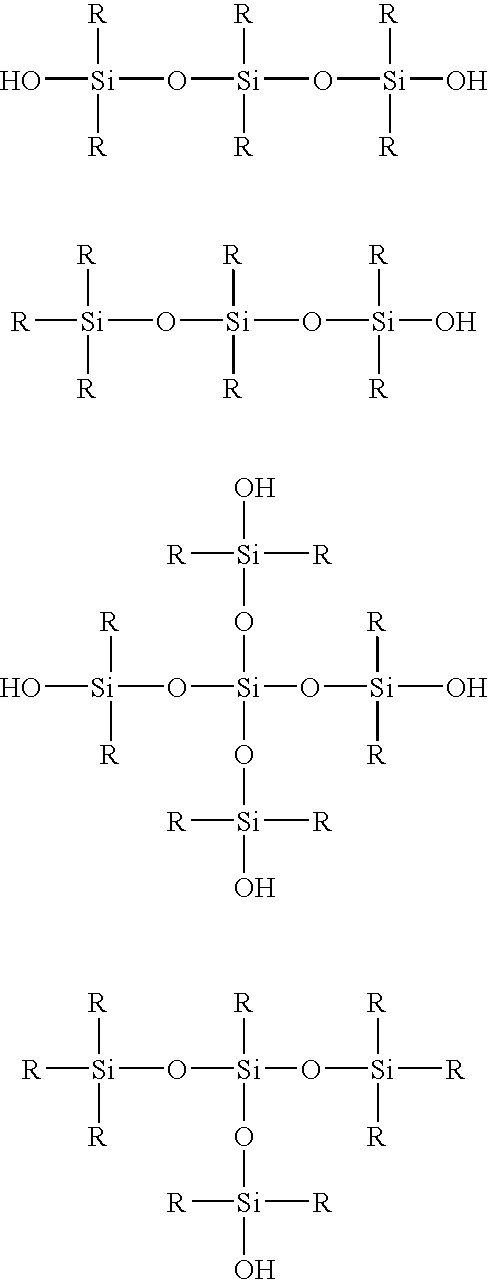Silanol-functionalized compounds for the preparation of polyurethane foams
a technology of polyurethane foam and functionalized compounds, which is applied in the field of polyurethane foam, can solve the problems of reducing raw materials and processing costs, affecting the quality of polyurethane foam, and affecting the quality of polyurethane foam, and achieves good dimensional stability, high efficiency, and reduced voc emissions
- Summary
- Abstract
- Description
- Claims
- Application Information
AI Technical Summary
Benefits of technology
Problems solved by technology
Method used
Image
Examples
example 1
[0063] Table 1 below illustrates the formulation components used in the production of polyurethane foam formulations A-C. Polyurethane foams A-C were made using a hand-mix technique familiar to those skilled in the art. The surfactant and polyols were placed in a 1.9 liter cup and mixed at about 6000 rpm for about 25 seconds. Next, the amine pre-blend was added to the cup, and the contents were mixed for about 20 seconds. The TDI was added and mixed with the rest of the contents in the cup for about 5 seconds. Finally, the reaction mixture was poured into a 9.44 dm3 mold that was temperature controlled to about 68° C. A sufficient amount of the reaction mixture was used such that the final foam pad had an overall density of about 31.5 kg / m3. The foam was removed from the mold after about 240 seconds and tested for initial force to crush (FTC) 30 seconds after demold. Shrinkage was determined by a method described by Herrington, Hoch et al, “Flexible Polyurethane Foams”; The Dow Chem...
example 2
[0065] Table 3 below illustrates the formulation components used in the production of polyurethane foam formulations D-E. Polyurethane foams D-E were made on a Hi-Tech high pressure foam machine. The resin “B side” components were mixed and placed in a 5.5 gallon (20.8 L) tank which was agitated and maintained at about 72° F. (22° C.) under about 2.2 bar of nitrogen pressure. The TDI “A side” component was also contained in a 5.5 gallon (20.8 L) tank which was agitated and maintained at about 72° F. (22° C.) at about 2.2 bar of nitrogen pressure. Before a shot was made into a mold, material was first circulated through the lines and mixhead and back to the tanks to provide a uniform temperature throughout the mixing line. During the shot, hydraulic pistons were raised which allowed the resin and TDI components to mix via high pressure impingement mixing. The material from the mixhead was directed into a mold to produce a flexible molded pad. Molds were maintained at about 155° F. (6...
PUM
| Property | Measurement | Unit |
|---|---|---|
| Fraction | aaaaa | aaaaa |
| Structure | aaaaa | aaaaa |
| Flexibility | aaaaa | aaaaa |
Abstract
Description
Claims
Application Information
 Login to View More
Login to View More - R&D
- Intellectual Property
- Life Sciences
- Materials
- Tech Scout
- Unparalleled Data Quality
- Higher Quality Content
- 60% Fewer Hallucinations
Browse by: Latest US Patents, China's latest patents, Technical Efficacy Thesaurus, Application Domain, Technology Topic, Popular Technical Reports.
© 2025 PatSnap. All rights reserved.Legal|Privacy policy|Modern Slavery Act Transparency Statement|Sitemap|About US| Contact US: help@patsnap.com



